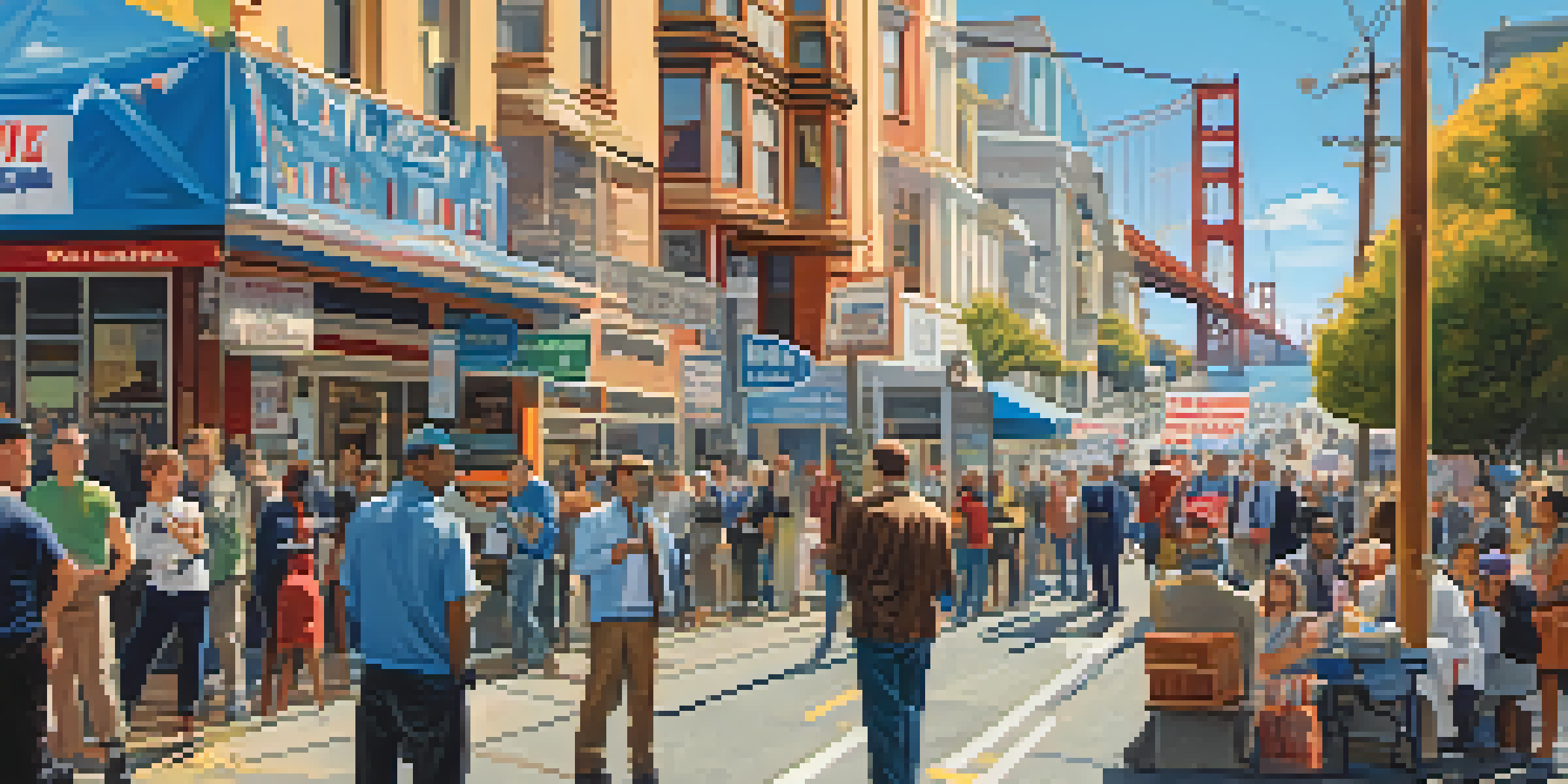Voter Turnout: Analyzing Trends in San Francisco Elections

Understanding Voter Turnout: Why It Matters
Voter turnout is a vital indicator of a healthy democracy. When citizens engage in elections, it reflects their investment in the political process and their desire for change. Higher turnout rates often lead to more representative outcomes, ensuring that diverse voices are heard in governance.
The vote is the most powerful nonviolent tool we have.
In San Francisco, understanding voter turnout can reveal much about community engagement and political sentiment. It allows us to analyze how various demographics participate in elections and what factors influence their decisions to vote or abstain. This knowledge is crucial for policymakers and community leaders aiming to increase civic participation.
Additionally, trends in voter turnout can influence future elections. If certain groups consistently vote at lower rates, targeted efforts can be made to mobilize them. This not only improves representation but also fosters a more inclusive civic environment.
A Brief History of San Francisco Elections
San Francisco has a rich electoral history, marked by diverse political movements and significant social changes. Going back to the early 20th century, the city saw various reforms aimed at increasing voter participation, like the introduction of the secret ballot. These reforms were crucial in shaping the electoral landscape we see today.

In recent decades, San Francisco has become known for its progressive politics, attracting a unique voter base. Elections often focus on issues such as housing, climate change, and social justice, which resonate deeply with residents. Understanding this historical context helps us see how voter turnout has evolved over time alongside shifting political priorities.
Voter Turnout Reflects Democracy Health
High voter turnout indicates active civic engagement, ensuring diverse voices are represented in governance.
Moreover, significant events like the dot-com boom and the housing crisis have influenced voter engagement. Each election cycle offers a snapshot of the city's priorities, making it essential to analyze turnout trends in relation to these historical events.
Key Demographics Influencing Voter Turnout
Demographic factors play a significant role in determining voter turnout in San Francisco. Age, ethnicity, and education level are just a few of the variables that can affect who shows up at the polls. For instance, younger voters often have lower turnout rates compared to older generations, which can shift electoral outcomes dramatically.
Democracy is not a spectator sport.
San Francisco is known for its diverse population, with significant communities of Asian, Latino, and African American voters. Each of these groups may have different priorities and motivations for voting, which can impact turnout. By examining these demographic trends, we can better understand the electoral landscape and identify areas for improvement.
Additionally, socioeconomic factors also influence participation. Residents facing economic hardships may feel disillusioned with the political process, leading to lower turnout. Targeted outreach and education can help bridge these gaps and encourage broader civic engagement.
Recent Trends in Voter Turnout
In recent elections, San Francisco has witnessed fluctuations in voter turnout that reflect broader national trends. While some elections, like presidential races, tend to see higher participation, local elections often struggle to engage voters. For example, the 2020 presidential election saw a turnout of over 80%, compared to around 30% in local elections.
These discrepancies raise questions about the factors that motivate voters. Issues on the ballot, the candidates running, and even the methods of voting—such as mail-in ballots—can significantly influence turnout. Analyzing these trends helps identify what drives citizens to engage or disengage from the electoral process.
Demographics Shape Voting Trends
Factors like age, ethnicity, and socioeconomic status significantly influence voter participation in San Francisco.
Furthermore, the impact of outreach efforts and voter education campaigns cannot be overstated. Initiatives aimed at increasing awareness about local elections have shown promise in boosting participation. This highlights the importance of continuous efforts to engage the community.
The Role of Technology in Mobilizing Voters
Technology has revolutionized the way voters engage with elections, and San Francisco is no exception. From online voter registration to social media campaigns, digital tools have made it easier for citizens to access information and participate in the electoral process. This shift has been particularly beneficial for younger voters who are more tech-savvy.
Social media platforms play a crucial role in mobilizing voters, allowing for targeted outreach and real-time engagement. Candidates and advocacy groups leverage these tools to inform and energize constituents, potentially increasing turnout. For example, viral campaigns can draw attention to key issues, motivating individuals to vote.
However, reliance on technology also raises concerns about misinformation and digital divides. Not all demographics engage equally with technology, and disparities can lead to unequal access to information. Addressing these challenges is essential to ensure that all voices are heard in the democratic process.
The Impact of Mail-In Voting on Turnout
Mail-in voting has transformed the electoral landscape, especially in response to the COVID-19 pandemic. San Francisco embraced this method to ensure that voters could participate safely, leading to record-high turnout in the 2020 elections. Many voters appreciated the convenience of casting their ballots from home, which eliminated barriers associated with traditional voting methods.
Research indicates that mail-in voting can increase participation among demographics that may face challenges in getting to polling places, such as the elderly or those with disabilities. It also allows for more thoughtful voting, as individuals can take their time to research candidates and issues.
Technology and Mail-In Voting Boost Turnout
Modern methods, including mail-in voting and social media outreach, have made it easier for citizens to engage in the electoral process.
However, mail-in voting isn't without its challenges. Issues such as ballot tracking and the potential for postal delays can create anxiety among voters. Ongoing efforts to improve the mail-in voting system will be crucial in maintaining turnout levels in future elections.
Looking Ahead: Strategies to Increase Voter Turnout
As we look to the future, it's vital to implement strategies that can effectively increase voter turnout in San Francisco. Community engagement initiatives, such as workshops and informational campaigns, can educate residents about the importance of their vote and how to participate in elections. These efforts should be tailored to meet the unique needs of diverse demographics.
Collaboration between local organizations, schools, and government agencies can create a more robust network for encouraging civic participation. Programs aimed at younger voters, such as peer-led outreach, could help bridge the participation gap seen in previous elections.

Ultimately, fostering a culture of voting requires ongoing commitment and innovation. By addressing barriers to participation and utilizing technology wisely, San Francisco can work towards ensuring that every eligible voter has the opportunity to make their voice heard.